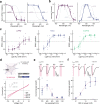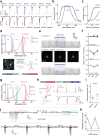This is a preprint.
A bistable inhibitory OptoGPCR for multiplexed optogenetic control of neural circuits
- PMID: 37425961
- PMCID: PMC10327178
- DOI: 10.1101/2023.07.01.547328
A bistable inhibitory OptoGPCR for multiplexed optogenetic control of neural circuits
Update in
-
A bistable inhibitory optoGPCR for multiplexed optogenetic control of neural circuits.Nat Methods. 2024 Jul;21(7):1275-1287. doi: 10.1038/s41592-024-02285-8. Epub 2024 May 29. Nat Methods. 2024. PMID: 38811857 Free PMC article.
Abstract
Information is transmitted between brain regions through the release of neurotransmitters from long-range projecting axons. Understanding how the activity of such long-range connections contributes to behavior requires efficient methods for reversibly manipulating their function. Chemogenetic and optogenetic tools, acting through endogenous G-protein coupled receptor (GPCRs) pathways, can be used to modulate synaptic transmission, but existing tools are limited in sensitivity, spatiotemporal precision, or spectral multiplexing capabilities. Here we systematically evaluated multiple bistable opsins for optogenetic applications and found that the Platynereis dumerilii ciliary opsin (PdCO) is an efficient, versatile, light-activated bistable GPCR that can suppress synaptic transmission in mammalian neurons with high temporal precision in-vivo. PdCO has superior biophysical properties that enable spectral multiplexing with other optogenetic actuators and reporters. We demonstrate that PdCO can be used to conduct reversible loss-of-function experiments in long-range projections of behaving animals, thereby enabling detailed synapse-specific functional circuit mapping.
Figures
















References
Publication types
Grants and funding
LinkOut - more resources
Full Text Sources
